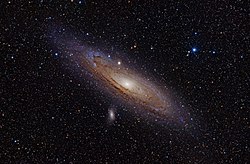Gáláksì Andromẹ́dà
| Àyọkà yìí únfẹ́ ìyílédèdà sí Yorùbá. Ẹ ran Wikipedia lọ́wọ́ ṣàtúnṣe sí ìyílédèdà |
Gáláksì Andromẹ́dà ( /ænˈdrɒmɪdə/) ni gáláksì alọ́ra tó fi bíi ọdún-ìtànmọ̀lẹ̀ 2.5 mílíọ̀nù (2.4 × 1019 km) jìnnà sí Ayé[4] tó sì wà ní iṣúpọ̀-ìràwọ̀ Andromeda. Also known as Messier 31, M31, or NGC 224, it is often referred to as the Great Andromeda Nebula in older texts. The Andromeda Galaxy is the nearest spiral galaxy to our Milky Way galaxy, but not the closest galaxy overall. It gets its name from the area of the sky in which it appears, the constellation of Andromeda, which was named after the mythological princess Andromeda. The Andromeda Galaxy is the largest galaxy of the Local Group, which also contains the Milky Way, the Triangulum Galaxy, and about 30 other smaller galaxies. Although the largest, the Andromeda Galaxy may not be the most massive, as recent findings suggest that the Milky Way contains more dark matter and could be the most massive in the grouping.[11] The 2006 observations by the Spitzer Space Telescope revealed that M31 contains one trillion (1012) stars:[8] at least twice the number of stars in the Milky Way galaxy, which is estimated to be 200–400 billion.[12]
| Gáláksì Andromẹ́dà | |
|---|---|
 Gáláksì Andromẹ́dà | |
| Observation data (J2000 epoch) | |
| Pronunciation | |
| Constellation | Andromeda |
| Right ascension | 00h 42m 44.3s[1] |
| Declination | +41° 16′ 9″[1] |
| Redshift | z = −0.001 (minus sign indicates blueshift) |
| Helio radial velocity | −301 ± 1 km/s[2] |
| Distance | 2.54 ± 0.06 Mly (778 ± 17 kpc)[2][3][4][5][6][lower-alpha 1] |
| Type | SA(s)b[1] |
| Mass | ~1 × 1012[2][7] M☉ |
| Number of stars | 1 trillion (1012)[8] |
| Apparent dimensions (V) | 190′ × 60′[1] |
| Apparent magnitude (V) | 3.44[9][10] |
| Absolute magnitude (V) | −20.0[lower-alpha 2][4] |
| Other designations | |
| M31, NGC 224, UGC 454, PGC 2557, 2C 56 (Core),[1] LEDA 2557 | |
| See also: Galaxy, List of galaxies | |
 | Àyọkà yìí tàbí apá rẹ̀ únfẹ́ àtúnṣe sí. Ẹ le fẹ̀ jù báyìí lọ tàbí kí ẹ ṣàtúnṣe rẹ̀ lọ́nà tí yíò mu kúnrẹ́rẹ́. Ẹ ran Wikipedia lọ́wọ́ láti fẹ̀ẹ́ jù báyìí lọ. |
Itokasi
Àṣìṣe ìtọ́kasí: <ref> tags exist for a group named "lower-alpha", but no corresponding <references group="lower-alpha"/> tag was found